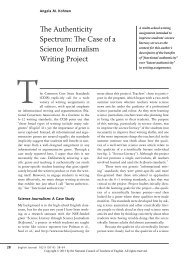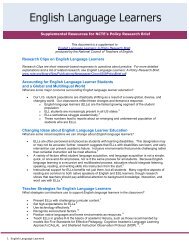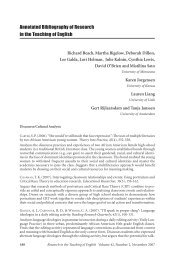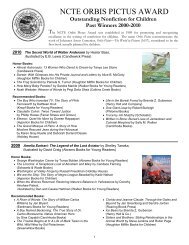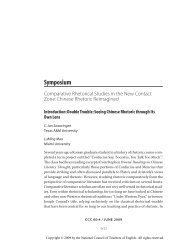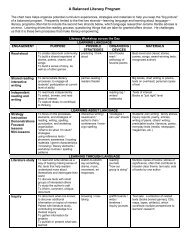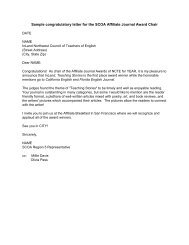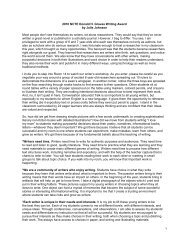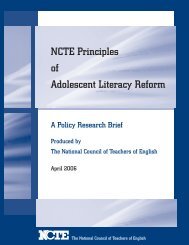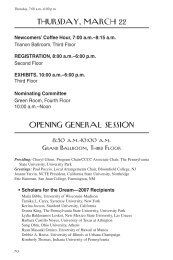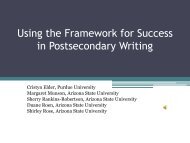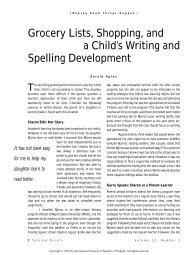Annotated Bibliography of Research in the Teaching of English
Annotated Bibliography of Research in the Teaching of English
Annotated Bibliography of Research in the Teaching of English
- No tags were found...
Create successful ePaper yourself
Turn your PDF publications into a flip-book with our unique Google optimized e-Paper software.
232 <strong>Research</strong> <strong>in</strong> <strong>the</strong> Teach<strong>in</strong>g <strong>of</strong> <strong>English</strong> Volume 41 November 2006SWANSON, T. J., HODSON, B. W., & SCHOMMER-AIKINS, M. (2005). An exam<strong>in</strong>ation <strong>of</strong> phonologicalawareness treatment outcomes for seventh-grade poor readers from a bil<strong>in</strong>gual community.Language, Speech, and Hear<strong>in</strong>g Services <strong>in</strong> Schools, 36(4), 336-345.THUNE, E., BAZZANELLA, C., & LEONARDI, S. (2006). Gender, language and new literacy: A multil<strong>in</strong>gualanalysis. London: Cont<strong>in</strong>uum International.UCHIKOSHI, Y. (2005). Narrative development <strong>in</strong> bil<strong>in</strong>gual k<strong>in</strong>dergarteners: Can Arthur help?Developmental Psychology, 41(3), 464-478.VAN SLUYS, K. (2006). “See<strong>in</strong>g <strong>the</strong> possibilities”: Learn<strong>in</strong>g from, with, and about multil<strong>in</strong>gualclassroom communities. Language Arts, 83(4), 321-331.VAUGHN, S., LINAN-THOMPSON, S., & MATHES, P. G. (2006). Effectiveness <strong>of</strong> Spanish <strong>in</strong>terventionfor first-grade <strong>English</strong> language learners at risk for read<strong>in</strong>g difficulties. Journal <strong>of</strong> Learn<strong>in</strong>g Disabilities,39(1), 56-73.VILLALVA, K. E. (2006). Hidden literacies and <strong>in</strong>quiry approaches <strong>of</strong> bil<strong>in</strong>gual high school writers.Written Communication, 23(1), 91-129.YOUNG, T. A., & HADAWAY, N. L. (EDS.). (2006). Support<strong>in</strong>g <strong>the</strong> literacy development <strong>of</strong> <strong>English</strong>learners: Increas<strong>in</strong>g success <strong>in</strong> all classrooms. Newark, DE: International Read<strong>in</strong>g Association.ZENTELLA, A. C. (ED.). (2005). Build<strong>in</strong>g on strengths: Language and literacy <strong>in</strong> Lat<strong>in</strong>o families andcommunities. New York: Teachers College Press.ZHA, S., KELLY, P., & PARK, M. K. (2006). An <strong>in</strong>vestigation <strong>of</strong> communicative competence <strong>of</strong> ESLstudents us<strong>in</strong>g electronic discussion boards. Journal <strong>of</strong> <strong>Research</strong> on Technology <strong>in</strong> Education,38(30), 349-367.Technology/MediaAUSTIN, E. W., CHEN, Y., PINKLETON, B. E., & JOHNSON, J. Q. (2006). Benefits and costs <strong>of</strong> ChannelOne <strong>in</strong> a middle school sett<strong>in</strong>g and <strong>the</strong> role <strong>of</strong> media-literacy tra<strong>in</strong><strong>in</strong>g. Pediatrics, 117(3), 423-433.Compares <strong>in</strong>structional effects <strong>of</strong> media analysis on middle-school students’ understand<strong>in</strong>g <strong>of</strong>Channel One programm<strong>in</strong>g—with some students receiv<strong>in</strong>g media analysis <strong>in</strong>struction versus acontrol group that did not receive <strong>in</strong>struction. F<strong>in</strong>ds that students <strong>in</strong> all groups remember moreads than news stories. Students receiv<strong>in</strong>g <strong>in</strong>struction recall more news stories and ads and viewed<strong>the</strong> ads from a more critical perspective than control group students; about a third <strong>of</strong> <strong>the</strong> studentsthought that <strong>the</strong> school had control over <strong>the</strong> ads. Suggests <strong>the</strong> need for media-literacy<strong>in</strong>struction <strong>in</strong> conjunction with us<strong>in</strong>g Channel One programm<strong>in</strong>g.BEEGHLY, D. G. (2005). It’s about time: Us<strong>in</strong>g electronic literature discussion groups with adultlearners. Journal <strong>of</strong> Adolescent & Adult Literacy, 49(1), 12-21.Investigates how 40 graduate students’ participation <strong>in</strong> Blackboard onl<strong>in</strong>e discussions aboutteach<strong>in</strong>g YA literature affects <strong>the</strong>ir discourse and learn<strong>in</strong>g. F<strong>in</strong>ds that discuss<strong>in</strong>g a book onl<strong>in</strong>eover a period <strong>of</strong> time enhances both <strong>the</strong>ir <strong>in</strong>dividual understand<strong>in</strong>gs and <strong>the</strong> quality <strong>of</strong> <strong>the</strong>irgroup’s discussion due to time for reflection and organiz<strong>in</strong>g thoughts before post<strong>in</strong>g discussionitems. Attributes some <strong>of</strong> <strong>the</strong> success <strong>of</strong> <strong>the</strong> onl<strong>in</strong>e discussions to face-to-face support <strong>in</strong> class.BLACK, A. (2005). The use <strong>of</strong> asynchronous discussion: Creat<strong>in</strong>g a text <strong>of</strong> talk. ContemporaryIssues <strong>in</strong> Technology and Teacher Education, 5(1), 5-24.Reports on <strong>the</strong> use <strong>of</strong> asynchronous discussion as part <strong>of</strong> a college-level literacy course. Notesthat this preferred discussion form creates a “text <strong>of</strong> talk” <strong>of</strong> students’ reflection and scaffold<strong>in</strong>g.Cautions that although this text <strong>of</strong> talk that has <strong>the</strong> potential to promote reflection, given <strong>the</strong>response time and removal <strong>of</strong> <strong>the</strong> <strong>in</strong>structor as <strong>the</strong> dom<strong>in</strong>ant presence as <strong>in</strong> face-to-face discussions,<strong>in</strong>structors need to structure onl<strong>in</strong>e discussions to promote both communication and



